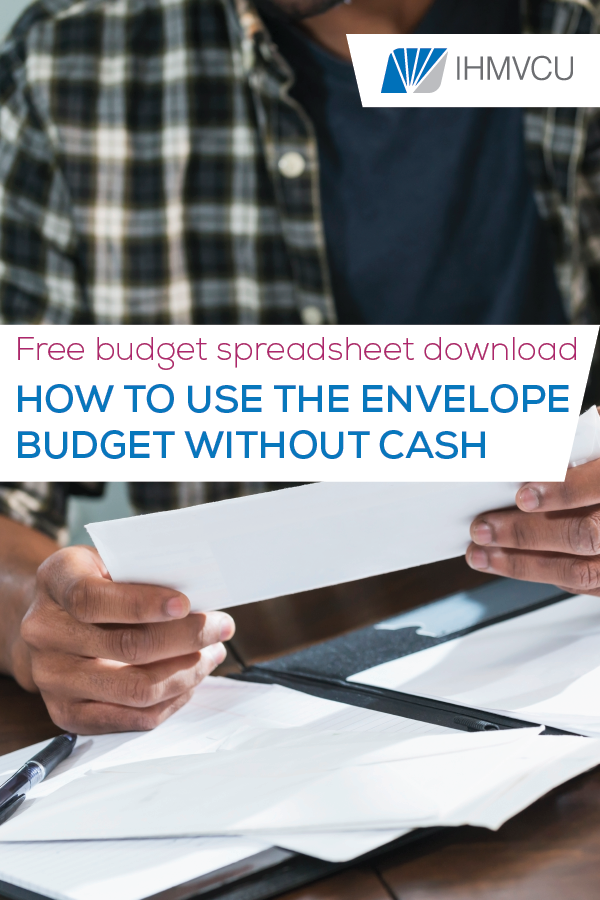Money Smarts Blog
How to use the envelope budget without cash [FREE DOWNLOAD]
Jan 18, 2018 || Amanda Spurgeon

Creating and following a budget is essential to maintaining good financial health. The only problem is that creating and updating that budget can be. . . well, boring. Especially if you’re trying to maintain some multi-tab, formula-filled, overly-complicated spreadsheet. Who has time for that?
If you’re not a spreadsheet person, the next best option is to use a cash-based budget – like Dave Ramsay’s famous envelope budget method, which is extremely effective for a lot of people. But, if you’re like me and lose your car keys every day and need a pager to help you find your cellphone, I wouldn’t suggest you start carrying around envelopes of cash. If you lose that, it’s gone forever.
So, where’s the middle ground? That’s where what I’m calling the Lazy Girl’s (or guy’s) Guide to the Envelope Budget Without Cash comes in. It brings together the best of both worlds: you don’t have to carry cash and spreadsheet involvement is minimal. Plus, it’s relatively hands-off, meaning you don’t have to spend hours every month messing with it. It’s as close to a set-it-and-forget-it budget as they come.
Like the envelope budget system, you take money from every paycheck and put it aside to be used only for a designated expense, like the water bill or cable. For example: if your cable bill is $100 and you get paid twice a month, you’d take $50 each check and put it into your cable bill “envelope.” Repeat for your other various bills and expenses.
Unlike the envelope system, you don’t have to take any cash out or buy any envelopes. Instead you transfer the money from your checking account to a separate “bills” account – this can be one account or several. Whether you choose multiple accounts or just one should be based on your will power and organization skills.
Ready to get down to the nitty gritty?
Here are the setup details:
Take a deep breath and get your head in the game. Then, download this budget spreadsheet. Take a minute to absorb it. I’ll wait.
I know what you’re thinking. This isn’t a budget. This is a very short and useless sheet with four blank columns. Guess what? That’s the beauty of it. You have to fill some stuff in, but I promise it’s easy.
Column 1 = due date
Column 2 = Payee
Column 3 = Amount due
Column 4 = Payroll deduction
Now, fill in those first three columns with all your bills.
I only use this spreadsheet for my set expenses, like Netflix and my mortgage. For what I call “kind of flexible expenses,” like my water bill which is almost always the same amount, I assume it will be the most expensive it’s ever been every month. We’ll get to variable expenses like groceries and having fun later.
Once this is filled in, you need to do a little math and determine how much you need to take from each paycheck to pay all your bills. I get paid weekly so, assuming 4 weeks in a month, I take $112.50 out of every check for my mortgage, $25.66 for my cell phone bill, $22.29 for my student loans and so on. You’ll want these written down somewhere, so you put them in the fourth column (D) titled Payroll Deductions.
Filling your “envelopes”
Once you have your D column filled in with your contributions from each pay check, you need to decide where those contributions will go and how they’ll get there.
Where is easy:
Somewhere other than your checking account. This can be a different savings account for every single bill, or just one savings account that serves as a bill bucket account. Choose whatever is more manageable for you. For me, it’s one account. Whatever you choose, it shouldn’t be tied to your debit card, so you can’t access it from an ATM or swipe to use it.
There are a few more options for how:
If your employer offers direct deposit, you can set up what are known as pay-roll allocations, so all of your bill money goes directly into whichever account you set up for it. That way it never even hits your checking account and you’re never tempted to use it for something else.
The other option is to set up automatic transfers from your checking account on pay days. If you’re going the one-account-for-every-bill route, you’ll need to set up that many transfers. If you’re using one account for all of them, find the sum of column D, and set up one transfer for that amount to your bill account.
Paying your bills
This is where all the action happens.
It’s rare, but my paycheck does vary occasionally. For that reason, I prefer not to automate my payments and instead schedule them manually.
Every payday, pull up your online banking and that spreadsheet. Find the bills that are due before the next payday, and transfer those amounts back to your checking and schedule your payments. I use Bill Pay, because I like being able to see all the money coming in and out on one page.
If you don’t mind your money moving automatically, you can schedule automatic transfers back to your checking account and use auto-pay for your bills. The payment part is up to you!
Variable expenses and wants
I know what you’re thinking now. But Amanda, what about my groceries and fun money?!
Well, after all your bill money has been moved to your digital “envelopes,” what’s left is yours to spend how you please.
If it’s not enough to buy your groceries and have fun within reason, you need to cut back. Look at that spreadsheet and reduce or cut things you really don’t need (i.e. that gym you’re paying for but never go to or your dog’s treat of the month subscription).
And there it is. A very lazy way to make sure you pay your bills and don’t overspend. Is it perfect? No. Does it work until you have the energy or organization skills to develop your own overly-complicated spreadsheet budget? It sure does.
If you haven't already, now's the perfect time to download the Lazy Girl’s Cashless Envelope Budget Spreadsheet and see how it can help you manage your spending.
